Once Alice falls through the rabbit-hole into Wonderland, the reality that surrounds her undergoes profound change while her strategies for dealing with that reality do not. Wonderland presents her with a myriad of shifting categories; boundaries — such as those between animal and human, decorum and rudeness, order and chaos — are continually violated. Alice in Wonderland is especially demonstrative of the fantasy genre because Alice, a stranger to Wonderland, realizes the fantastical nature of the world that surrounds her and must constantly work to navigate and understand it. Works like fairy tales, on the contrary, present self-contained worlds to which their characters are accustomed. While encountering a fire-breathing dragon may seem remarkably fantastical to a reader of The Hobbit, Bilbo Baggins, though admittedly terrified of the creature, recognizes the dragon as part of his world and possesses skills with which to combat it. Alice's experiences are much more jarring to her sense of reality, as W. H. Auden describes: "In Wonderland, Alice has to adjust herself to a life without laws . . . She has to learn for example to walk away from a place in order to reach it . . . In Wonderland, she is the only person with self-control" (9). Lewis Carroll demonstrates the lawless nature of Wonderland through fantastical inversions of logic, like having to walk away from a destination in order to achieve it, and of nature, like a rabbit which can talk and wear a waistcoat. Continuous border-violations and inversions therefore become characteristic of Alice in Wonderland's fantasy, as Eric Rabkin points out: "the fantastic is fantastic, then, not by virtue of simply violating some rules we have picked up in the real world, but by virtue of reversing the ground rules we are following at any given moment of reading" (20).
In addition to Lewis Carroll's verbal conception of the fantastical, his illustrator John Tenniel enlarges Wonderland with visual portrayals of fantastic inversion and alterations of perspective and relative size. Visual illustration immediately immerses the reader into the book's world, though Tenniel, echoing Carroll's strategy for his fantastic writing, uses aspects of the familiar as points of departure to track Alice's descent further and further into Wonderland's madness.
The appearance of the White Rabbit, both in picture and in prose, shows how the author and the illustrator ease Alice (and her surrogate explorer, the reader) into Wonderland. Boredom with her sister's book "without pictures or conversations" causes Alice to drift suddenly into a dream-world:
So she was considering, in her own mind (as well as she could, for the hot day made her feel very sleepy and stupid), whether the pleasure of making a daisy-chain would be worth the trouble of getting up and picking the daisies, when suddenly a White Rabbit with pink eyes ran close by her.
There was nothing so very remarkable in that; nor did Alice think it so very much out of the way to hear the Rabbit say to itself "Oh dear! Oh dear! I shall be too late!" (when she thought it over afterwards it occurred to her that she ought to have wondered at this, but at the time it all seemed quite natural); but, when the Rabbit actually took a watch out of its waistcoat pocket, and looked at it, and then hurried on, Alice started to her feet, for it flashed across her mind that she had never before seen a rabbit with either a waist-coat pocket, or a watch to take out of it, and burning with curiosity, she ran across the field after it, and was just in time to see it pop down a large rabbit-hole under the hedge. [Carroll 7-8]

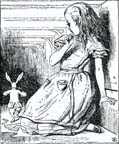
Carroll begins with a very ordinary, almost dull, scene in which a little girl, exhibiting a characteristically small attention span, becomes dissatisfied with her current activity. The adult reader can extrapolate from Carroll's writing that Alice has fallen asleep and begun to dream when the White Rabbit appears, but Carroll does not explicitly describe this process (he only hints at it by mentioning Alice's sleepy state and reclined position). Carroll does not blur the boundary between the real and fantastical worlds by explicitly describing the mediating dream state; instead he thrusts the fantastical element into the real world. Alice then acts by her own volition to follow the White Rabbit into the fantasy-world proper.
Carroll uses the White Rabbit, instead of the dream, to introduce Alice and the reader to the fantastical nature of Wonderland. The White Rabbit is, by far, the most human of the characters Alice will encounter underground (Carroll first shows the Rabbit's humanness by capitalizing White Rabbit like a formal, human name). What surprises Alice most about the Rabbit is not that it speaks (such an imaginative child as Alice likely hears animals talk all the time in her mind) but that it has human accoutrements. Tenniel chooses to illustrate this moment — when the Rabbit looks at his pocket-watch — and, following Alice's perspective, emphasizes that the Rabbit's human clothes make it odd. (This strategy makes sense when dealing with illustration because Tenniel cannot visually represent the Rabbit's speech as effectively as its clothing.) In the illustration, the anthropomorphic white rabbit holds the stop-watch with one human hand and tucks an umbrella under his arm with the other hand to strike an almost dandified posture. His eyes bulge wide in distress over the late time and, perhaps due to his tip-toeing rabbit-feet, he leans forward as if about to hurry (on two feet, of course) away. The reader, like Alice, realizes, detail by detail, how different this White Rabbit is from Carroll's first mention of a "White Rabbit with pink eyes" (7).
Although Alice considers the Rabbit's human dress fantastic, it also conversely serves to soften the intrusion of the fantastical into Alice's world for the reader. Especially in Tenniel's illustration, the rabbit's clothes, human hands, posture and expression of distress makes it familiar to us while its essentially realistic rabbit-body makes it recognizable. Tenniel inverts mutually exclusive conceptions of animal and man, but he also bridges that divide visually in order to create a point of departure for fantasy within the everyday world with which the reader is familiar. John Ruskin, the emminent Victorian art critic, commends artists of fantasy for combing realistic detail with fanciful intent in his comments about the illustrations of Kate Greenway:
It is true that the combination or composition of things is not what you can see every day. You can't everyday, for instance, see a baby thrown into a basket of roses; but when she has once pleasantly invented that arrangement for you, baby is as like a baby, and rose as like a rose, as she can possibly draw them . . . and the fairy land she creates for you is not beyond the sky nor beneath the sea, but nigh you, even at your doors. ["Lecture IV, Fairyland" in The Art of England qtd. in Johnson 9]
Ruskin's description readily applies to Tenniel's illustration of the White Rabbit. The juxtaposition of recognizable human and rabbit forms makes the appearance of such a creature in a normal meadow (Tenniel draws the grasses and flowers of the background as they would exist in reality) less jarring. Whereas Carroll focuses on the strangeness of the White Rabbit (stylistically shown in his extensive use of italics), Tenniel more effectively conveys the rabbit's humanness by emphasizing its anthropomorphic nature.
Though Alice expresses definite surprise at the appearance of the White Rabbit, she reacts to falling unexpectedly "down what seemed to be a very deep well" at the end of the rabbit-hole with muted wonder. Carroll, in chronicling Alice's transition from her reality to Wonderland, adopts a strategy similar to that which Anados, the main character of George MacDonald's Phantastes of 1858, describes:
It is no use trying to account for things in Fairy Land; and one who travels there soon learns to forget the very idea of doing so, and takes everything as it comes; like a child, who, being in a chronic condition of wonder, is surprised at nothing. [qtd. in Landow 37]
Alice, in addition to having a chronic condition of wonder characteristic of a child, approaches her quandary using the logic she has internalized from her aboveground reality (the logic that adults have taught to her). The fall through the rabbit-hole, at first, does little to shake Alice's way of interacting with the world that surrounds her:
First, she tried to look down and make out what she was coming to, but it was too dark to see anything: then she looked at the sides of the well, and noticed that they were filled with cupboards and bookshelves: here and there she saw maps and pictures hung upon pegs. She took down a jar from one of the shelves as she passed: it was labeled "ORANGE MARMALADE," but to her great disappointment it was empty: she did not like to drop the jar, for fear of killing somebody underneath, so she managed to put it into one of the cupboards as she fell past it. [Carroll 8]
Remnants of the recognizable world flood past Alice as she crosses the boundary between reality and Wonderland, perhaps helping to diminish the fear she feels at falling. Carroll, however, gives an indication of the confusion between word and object that Alice will soon experience: just because a jar is labeled "Orange Marmalade" does not mean that it actually is a jar full of orange marmalade. Alice's attempt to read the object correctly fails. Though she is likely familiar with being denied such sweet things as marmalade in her adult-controlled world, the denial of marmalade here comes from the thing itself, not from an external force of authority. The mislabeled marmalade jar shows that reading sings and rules in Wonderland will be very difficult because they often do not correspond to the underlying logic that governs the world aboveground. W.H. Auden attests to this problem of untrustworthy signs in Wonderland:
According to Lewis Carroll, what a child desires before anything else is that the world in which he finds himself should make sense. It is not the commands and prohibitions, as such, which adults impose that the child resents, but rather that he cannot perceive any law linking one command to another in a consistent pattern. [11]
Alice demonstrates that she does not resent prohibitions of adults when she places the jar back on a shelf so that she will not kill anyone standing below her. This action points to Alice's internalization of adult worries about children's potentially destructive and irresponsible acts. In her first experiences with Wonderland, Alice clings to the logic and behavior approved for her reality; Wonderland will soon challenge this reliance since its ground rules correspond neither to those of the real world nor to those of Wonderland as it existed in the text one page ago.
Alice further tries to apply the logic of schoolroom geography that she has learned in the real world to Wonderland when she describes her understanding of the inversion, the turning upside-down, that she experiences falling. She envisions the rabbit hole cutting through the earth to the other side where people exist upside down: "I wonder if I shall fall right through the earth! How funny it'll seem to come out among the people that walk with their heads downwards! The Antipathies, I think . . . " (Carroll 8). Carroll here introduces one of the linguistic inversions which categorize the verbal fantasy of Wonderland in the pun on antipodes. Ronald Reichertz tracks the pun's multiple levels of significance:
Alice gives a textbook definition of "antipodes" here but mispronounces the word as "antipathies," which is precisely what the antipodes introduce in Wonderland, physical antipathies (opposites) that both amuse and confuse Alice, resulting in a frequently painful emotional antipathy. [8]
By mistakenly calling the antipodes "antipathies," Alice transfers her physical travel to the opposite side of the world into semantic travel from one word that means "opposite side of the world" to another word that means "opposite in character." Carroll here shows how the boundary between physical movement and verbal movement blurs within the fantastic narrative. Alice fails to track her progression into Wonderland in both geographical and semantic terms. Brian Stableford shows how the fantastic aligns with wordplay and mutable geography:
Language, as a map of the world, is mutable in all sorts of ways which introduce happy absurdities and discontinuities into its work of reference. So it is with fiction, which maps human experience in a fashion analogous to the way in which language maps reality, and which generates many of its happy absurdities and discontinuities in the form of fantasy. [71]
Carroll therefore marks Alice's entrance into the fantastic world by pointing out the potential for inversion and confusion in her aboveground conceptions of language and geography.
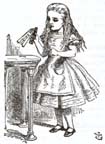
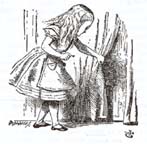
Once Alice reaches the long hallway at the bottom of the rabbit-hole, the fantastical environment begins to exert its influence over her. She looses her ability to manipulate the objects that she encounters in any controlled, predictable way. Tenniel's pair of illustrations that portray Alice in front of the tiny door and then holding the bottle that commands "Drink Me" demonstrate the environment's active nature in Wonderland. In the first illustration, Alice pulls back a curtain to reveal the door that leads into "a small passage, not much larger than a rat hole." She holds the key expectantly in her hand, but the tiny door will not allow Alice to enter the garden. Tenniel dramatically inverts the usual difference in sizes between a child and a door and emphasizes Carroll's irony: Alice has a key (the only thing that is usually required for successfully entering a door in the real world) yet she cannot bodily walk through the door. This disparity between environment and body inverts the assumption that environments are made to support the body's wants (which Alice would likely hold as the child of a bourgeois British family). Wonderland then further changes the content of Alice's surroundings:
She went back to the table . . . this time she found a little bottle on it ("which certainly was not here before," said Alice), and tied around the neck of the bottle was a paper label, with the words "DRINK ME" beautifully printed on it in large letters. [Carroll 10]
Alice again applies her logic to the bottle — claiming that the bottle's contents are drinkable as long as it is not marked "poison" (she clearly did not learn the lesson of the orange marmalade). Tenniel's illustration shows Alice on the brink of drinking the liquid, confident in her stance that the bottle's contents will prove harmless. Although Alice thinks she controls her environment by means of logical investigation, this situation points out the fallacies inherent in her programmatic ways of thinking. The bottle's contents may eventually allow Alice to fulfill her wish to journey through the door, but she does not control her own progression to that desired end. Tenniel demonstrates Alice's false sense of control by presenting the tense position Alice often occupies in Wonderland: in both illustrations, she is pictured right before her grasp of the environment and its ground rules fails.
Carroll establishes Wonderland's hold over Alice when it takes control of her body and interactions with the environment. Alice thinks she has discovered the logic behind eating or drinking and its corresponding growth, but Carroll once again pulls the rug out from under her:
Soon her eye fell on a little glass box that was lying under the table: she opened it, and found in it a very small cake, on which the words "EAT ME" were beautifully marked in currants. "Well, I'll eat it," said Alice, "and if it makes me grow larger, I can reach the key; and if it makes me grow smaller, I can creep under the door: so either way I'll get into the garden and I don't care which happens!"
She ate a little bit, and said anxiously to herself, "Which way? Which way?", holding her hand on top of her head to feel which way it was growing; and she was quite surprised to find that she remained the same size. [Carroll 12]
Carroll here reverses the ground rules that Alice's previous experience with the "Drink Me" bottle established. The correct way to read external reality is never clear in Wonderland. Rabkin establishes this further inversion as characteristic of Alice in Wonderland's fantasy:
Carroll, by providing Alice with an ordinary experience, makes his narrative even more fantastic, for this ordinary experience functions as a reversal of the ground rules then operating, and it surprises both Alice and the reader . . . Alice, in staying the same size, takes a non-action which, in context, is a fantastic bit of plot; in asking "Which way? Which way?" she reminds us of the theme of change and development, but that theme is suddenly reversed . . . [21, 22]
The failure of the "Eat Me" cake to take immediate effect over Alice's body shows the difference between the fantasy of Alice in Wonderland and that of the traditional fairy tale. Though fairy tales offer an alternative to the real world, the formation of that alternative world is the only fantastic reversal that occurs (Rabkin 162). The fairy tale's ground rules do not constantly shift — and shift on multiple planes including the narrative, thematic and linguistic — as they do in Alice in Wonderland.

Though Carroll and Tenniel begin Alice in Wonderland with a bridge between reality and Wonderland — the White Rabbit — that allows the reader to enter somewhat gradually into the fantastical, they soon separate the two components of the anthropomorphic animal to violate fully the boundary between animal and man. By means of Alice's diminishments in size, she becomes similar to the Mouse she encounters swimming in the pool of tears. In the illustration for this scene, Tenniel emphasizes the characteristics that Alice and the Mouse share. Their positions in the water are strikingly similar — both stretch their hands (again the animal has human hands) out forward, kick their legs back and hold their heads above water — and, though they head in opposite directions, their bodies overlap in the visual frame. Carroll presses this similarity between Mouse and girl further towards inversion by giving the Mouse a fuller understanding of human decorum than Alice. Lost in her memory of Dinah, Alice offends the Mouse:
" . . . and she's such a capital thing for catching mice — oh, I beg your pardon!" cried Alice again, for this time the Mouse was bristling all over, and she felt certain it must really be offended. "We won't talk about her any more, if you'd rather not."
"We, indeed!" cried the Mouse, who was trembling down to the end of its tail. "As if I would talk on such a subject! Our family always hated cats: nasty, low, vulgar things! Don't let me hear the name again!" [Carroll 18-19]
Alice, unaccustomed to speaking with mice, underestimates the Mouse's sensitivity to discussing cats. The Mouse's denial of Alice's "we" and his invocation of family aligns him with the adults in Alice's reality who likely try to correct any of her childish faux pas. Alice's lack of realization about the danger of cats to the Mouse also shows her continuing belief in static identity. Harry Levin points out that "her shrinkages have taught her to look at matters from the other side, from the animals' vantage point," but only with a concern for maintaining proper decorum (184). Alice glosses over the more fearful aspect of her newfound smallness: not that she offends mice without meaning to, but that she could be eaten like the mice. Alice does not recognize that her beloved cat Dinah would likely not differentiate between her and a regular mouse; she still conceives of herself as the child that existed outside of Wonderland. Again, Wonderland's boundary-crossing changes jeopardize Alice's predefined sense of self without her fully knowing it.
The interaction between the Mouse and Alice proceeds to include linguistic reversals as well as behavioral. After the caucus-race in which a diverse group of animals participate, the Mouse agrees to tell his tale:
"Mine is a long and sad tale!" said the Mouse, turning to Alice and sighing.
"It is a long tail, certainly," said Alice, looking down with wonder at the Mouse's tail; "but why do you call it sad?" And she kept on puzzling about it while the mouse was speaking, so that her idea of the tale was something like this: — [Carroll 24]
Carroll then creates a visual embodiment of the pun by arranging the Mouse's tale typographically so that it forms the shape of a tail. He uses fantastic reversals — from word to object and from verbal punning to visual punning — to test the limits of language's applicability to the object-world. Alice discovers that Wonderland changes the nature of language and ordinary, verbal communication becomes as unreliable as Alice's growth cycles. Donald Rackin claims that this episode of the tale/tail shows how the meaning of words differs based on who speaks them:
When the Mouse asserts that his "is a long and sad tale," Alice replies, "It is a long tale . . . but why do you call it sad?" When the Mouse says "not," Alice thinks he refers to a knot. Here, then, another aboveground assumption (one that perplexed Charles Dodgson all his life) — that ordinary language, whether written or spoken, has at least the potential to be univocal — dissolves as swiftly and easily as the smiling Cheshire-Cat. And as Alice's adventures continue, this comic subversion of linguistic convention increases in both scope and intensity. [399]
The fantastic nature of Wonderland thus extends even to the level of ordinary words and their meanings and causes various upheavals in Alice's conception of how language effectively refers to reality.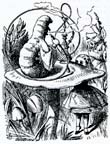
Carroll pushes the reversal of man and animal to even greater degree when Alice meets the hookah-smoking Caterpillar in Chapter V. Tenniel's illustration establishes a hierarchical relationship between Alice and the Caterpillar. The insect, pictured in profile facing away from the viewer, grasps the hookah with a human hand that emerges from a wide-sleeved shirt. The coil of his hookah wraps a fully around his body — creating a bordered circular shape that immediately draws the viewer's eye to the figure inside it. The mushroom upon which he sits raises him to the top of the picture-space. Alice, conversely, stands below the Caterpillar on tip-toe. His mushroom impedes the viewer's view of her body, cutting her off from midsection to nose. The eyes are the most noticeable feature in this depiction of Alice; she raises them up, widened in wonder, toward the Caterpillar. The naturalistically drawn plants in the background emphasize Alice's small size: shoots of leaves and foxgloves tower over her, hemming her into the Caterpillar's mushroom. The Caterpillar therefore dominates the visual space of the illustration, almost as if Tenniel envisioned a type of court scene in which the lowly Alice presents herself to the imperious insect.
The Caterpillar also assumes the dominant role in the verbal exchange that occurs between girl and insect. For the first time, Alice doubts her identity and shows that the continuous reversals — especially the dramatic alterations in her size — of Wonderland have altered her conception of reality as primarily predictable. The Caterpillar begins the conversation with a rude question that Alice answers politely (again inverting the relationship between decorum and indecorum, since previously the Mouse was polite while Alice was rude):
"Who are you?" said the Caterpillar.
This was not an encouraging opening for a conversation. Alice replied, rather shyly, "I — I hardly know, Sir, at present — at least I know who I was when I got up this morning, but I think I must have changed several times since then."
"What do you mean by that?" said the Caterpillar, sternly. "Explain yourself!"
"I ca'n't explain myself, I'm afraid, Sir," said Alice, "because I'm not myself, you see."
"I don't see," said the Caterpillar.
"I'm afraid I ca'n't put it more clearly," Alice replied, very politely, "For I ca'n't understand it myself to begin with; and being so many different sizes in a day is very confusing." [Carroll 35]
With the pun on "yourself" as meaning both "your actions" and "your self," Carroll demonstrates the impossibility of correctly answering the commonly used command "Explain yourself." Adults often behave like the caterpillar since they unremittingly demand children to answer questions to which the young people cannot know the answer. Here, Alice begins to understand the troubles that shroud self-explanation in a world that denies a static conception of self. Carroll here points to one of the key tenets of fantasy-writing — that it investigates the problems of individual thinking — according to Eric Rabkin:
What is known is known, and there is no use worrying about it. One can accept it, reject it, work to change it, or try to ignore it, but what is, is. The true field of freedom is in consideration of what is not, what might be, what we think. What we think and how we think . . . are inevitably crypto-subjects of fantasy, even when the overt subjects may be quite different. [14-15]
Alice faces a full disintegration of her aboveground way of thinking, since she does not even know "what is known" in Wonderland: it is fully a "field of freedom," one that often degrades into chaos.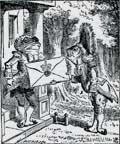
Chapter VI begins with the figures of the Frog- and Fish-Footmen whose anthropomorphic bodies remind the reader of the White Rabbit. Carroll, however, here changes the behavior of the anthropomorphic animal from the White Rabbit's all-too-human worry about tardiness to the Frog-Footman's nonsensical rudeness. Tenniel first intimates this difference in his illustration of the Frog-Footman. Unlike the White Rabbit, the footman is completely clothed from top to bottom — the only expressly frog-like characteristic is the head since the feet, body and hands are all humanoid. The two footmen also depart from the more naturalistic fantasy of the White Rabbit by means of their grotesque features: their bow-ties are exaggerated to a ridiculous degree, their feet form a perfect third position in ballet and their bodies rigidly adhere to formal meeting positions. Tenniel visually encapsulates the Frog-Footman's discourteous air by drawing his head lifted upwards with disdain and therefore emphasizing the downward curve of his mouth (which ordinarily occurs on a frog, but here is exaggerated due to the low angle at which the viewer sees him). Tenniel here demonstrates an effective strategy of fantastic illustration:
Essentially, fantastic subjects, like anthropomorphic renderings of objects and animals, are devices of transformation, and both art and literature possess the capacity to use many such devices, the most powerful of which change our usual means of perception. [Landow 31]
A person would likely not identify the emotion on an ordinary frog's face as arrogant rudeness, but Tenniel creates this sensation by means of fantastical exaggeration and perspective.In the text, the Frog-Footman's incomprehensible manner causes Alice to enter further into Wonderland's logic. He continually denies Alice's entrance to the Duchess's house (defying the nature of a normal foot-man who would readily open doors) and defers answering her questions:
"How am I to get in?" asked Alice again, in a louder tone.
"Are you to get in at all?" said the Footman. "That's the first question, you know."
It was, no doubt: only Alice did not like to be told so. "It's really dreadful," she muttered to herself, "the way all the creatures argue. It's enough to drive one crazy!"
The Footman seems to think this a good opportunity for repeating his remark, with variations. "I shall sit here," he said, "on and off, for days and days."
But what am I to do?" said Alice.
"Anything you like," said the Footman, and began whistling.
"Oh there's no use in talking to him," said Alice desperately: "he's perfectly idiotic!" And she opened the door and went in. [Carroll 46]
The Frog-Footman demonstrates that the creatures of Wonderland are completely at home in its chaos. His statement, "I shall sit here, on and off, for days and days," gives absolutely no information about what he actually will be doing in the coming days, but he utters it with complete nonchalance (my italics). Normalcy in Wonderland, like the Frog-Footman's plan for the coming days, is completely unknowable because it is always changing, always going on and off. Alice here reverses her previous course of action — when Wonderland threw an obstacle in her way, she would wait until it presented her with a solution in the form of a magical cake or otherwise. After trying to understand the Frog-Footman, Alice realizes that she will never understand him and, acting on her own volition, goes through the door without his assistance. Donald Rackin claims that
Alice's reaction to the Frog-Footman's argumentativeness is representative of her total reaction to this universal anarchy: "It's really dreadful . . . the way all the creatures argue. It's enough to drive one crazy!" . . . the key words "dreadful" and "crazy" subtly reveal what is happening to Alice without her knowing it; she is slowly coming to an unconscious perception of Wonderland's maddening — and dangerous — nature. [402-403]
Not only does Alice here perceive the inherent madness of Wonderland's nature but she begins to overturn her previous way of acting to cope more adequately with its nonsensicalness.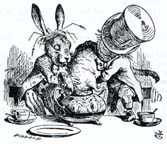
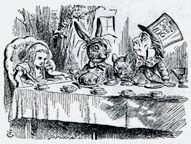
In Chapter VII, Alice reaches a pinnacle of Wonderland's fantastical disorder (the reader is immediately aware that Carroll uses the word "mad" in the chapter title, "A Mad Tea-Party," and therefore must be prepared for an escalation of pandemonium). Tenniel demonstrates the madness of the tea party first by means of the grotesque and then by violating precedents set in the chapter's first illustration in the third illustration. Tenniel establishes the fantastic nature of the scene in the first illustration more immediately than Carroll does in his first mention of it: "There was a table set out under a tree in front of a house, and the March Hare and the Hatter were having tea at it: a Doormouse was sitting between them fast asleep . . . (54). Alice abandons the politeness she previously exhibited when met with strange characters like the Frog-Footman and gives a disgruntled frown in the illustration. She cannot maintain the well-mannered faade required in her reality; such madness as the tea party contains breaks through it. Tenniel gives the March Hare clothes, an addition that fantastically contradicts the reason behind his name — hares are supposedly mad in March because that is their breeding season. The off-kilter crown of straw that the March Hare wears, however, may be a reminder of the animal's potential for frenzied behavior in fields. Tenniel emphasizes the natural construction of a rabbit's mouth — its lips pulled back to reveal teeth — in order to make its facial expression seem bizarre especially in comparison to its human garments. Showing the similarity between the two characters' madness, Tenniel then carries the rabbit's facial expression over to the Mad Hatter and, when combined with his protruding nose and bulging eyes, renders the human face a grotesque mishmash.

Tenniel, echoing the illustration of the two footmen, exaggerates the Hare's and Hatter's bow ties to give the normal clothes an air of eccentricity. The Hatter's hat aptly demonstrates the essence of the his madness: the identifying card for a hat of that size still clings to it, showing that the Hatter likely has mercury poisoning from making felt hats to be sold. Tenniel portrays the Doormouse as considerably larger than a normal mouse, almost on the same scale as Alice (especially when she slouches down in a chair as she does in this illustration) which reminds the viewer of a previous reversal in normal sizes when Alice met the Mouse in the pool of tears. The Doormouse's size, however, does not remain consistent in the illustrations for the mad tea party. In Tenniel's third illustration of that chapter, we see the March Hare and the Mad Hatter "trying to put the Dormouse into the teapot" — a teapot that could not possibly hold the Doormouse in the first illustration has enlarged itself so that the animal's head disappears inside of the pot (Carroll 60). What would otherwise be a mistake in Tenniel's draftsmanship between two scenes fits perfectly into the pattern of size-reversals found in Wonderland and adds a further, visual layer to the book's fantasy. The importance of Tenniel and Carroll's collaboration becomes especially apparent in these scenes: visual fantasy by means of the grotesque and changing perspectives enlarges the verbal fantasy of nonsensical puns and riddles.
One of the puns Carroll presents in "A Mad Tea-Party" contains another example of the reversal that characterizes Wonderland's fantasy. After the March Hare and Mad Hatter fail to provide an answer to their own riddle, Alice expresses her frustration:
Alice sighed wearily. "I think you might do something better with the time," she said, "than wasting it in asking riddles that have no answers."
"If you knew Time as well as I do," said the Hatter, "you wouldn't talk about wasting it. It's him."
"I don't know what you mean," said Alice.
"Of course you don't!" the Hatter said, tossing his head contemptuously. "I dare say you never even spoke to Time!"
"Perhaps not," Alice cautiously replied; "but I know I have to beat time when I learn music."
"Ah! That accounts for it," said the Hatter. "He wo'n't stand beating. Now, if you only kept on good terms with him, he'd do almost anything you liked with the clock . . . " [Carroll 56]
The Mad Hatter here personifies time into an actual human being (similarly to the animals, Carroll shows this personification stylistically by capitalizing time when the Hatter refers to it, but not when Alice does). In Wonderland, the aboveground conception of time as a reliable, unchanging system does not hold. Personified time is open to all the foibles and inconsistencies that plague actual humans. Beating time thus changes from Alice's normal conception of observing the regular intervals that time sets to the Hatter's conception of violence against another person. The Hatter therefore considers observing the regularity of time to be a sort of crime. Donald Rackin discusses the dangerous implications of the personified time that governs the mad tea party for Alice's aboveground reality:
This finally puts time in its proper place — another arbitrary, changeable artifact that has no claim to absolute validity, no binding claim, in fact, to existence. Since time is now like a person, a kind of ill-behaved child created by man, there is the unavoidable danger that he will rebel and refuse to be consistent. That is exactly what has happened in this Wonderland tea party: the Hatter says time "won't do a thing I ask! It's always six o'clock now"; that is, it is always tea-time. Time is thus frozen, and one of the most important concepts of common human experience is laughed out of existence. [405-406]
A time that is constantly shifting takes away one of the most basic ground rules for Alice's navigation of reality. The fantasy of Alice in Wonderland does not merely flout the applicability of linear time (as seen in works of fantasy that involve time-travel) but also that of any predictable time at all. Wonderland literalizes John Milton's definition of fantasy as a realm where "time and place are lost"; in fact, time and place are so lost in Wonderland that none of its residents even bother to look for them (qtd. in Johnson 10).
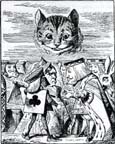
Even the rulers of Wonderland are unable to secure control of their subjects, as seen in the appearance of the Cheshire-Cat's head in Chapter VIII "The Queen's Croquet Ground." Alice greets the cat with considerable relief ("Now I shall have somebody to talk to," she states) since she cannot adequately cope with the croquet-players and their endless arguments. The pandemonium of croquet must indeed be considerable for Alice to consider such an unwieldy personage as the Cheshire-Cat a friend:
"Who are you talking to?" said the King, coming up to Alice, and looking at the Cat's head with great curiosity.
"It's a friend of mine — a Cheshire-Cat," said Alice: "allow me to introduce it."
"I don't like the look of it at all," said the King: "however, it may kiss my hand, if it likes."
"I'd rather not," the Cat remarked.
"Don't be impertinent," said the King, "and don't look at me like that!" He got behind Alice as he spoke.
"A cat may look at a king," said Alice. "I've read that in some book, but I don't remember where."
"Well, it must be removed," said the King very decidedly; and he called to the Queen, who was passing at the moment, "My dear! I wish you would have this cat removed!"
The Queen only had one way of settling all difficulties, great or small. "Off with his head!" she said without even looking around . . . [Carroll 68]
The King attempts to draw the Cheshire-Cat into the formalities of court behavior by asking it to kiss his hand. The Cat, in keeping with the anarchy in Wonderland, declines in a most informal way, especially since his facial expression maintains the sly smile. The Cat's smile, in fact, comes to represent him fully as evidenced by the pun on "look": the King does not like the look the Cat has on its face and therefore does not like the looks of it in general. The synecdoche of the smile is especially fitting for Wonderland, because Carroll can easily literalize it and bring it down from the figurative realm by causing the Cat to disappear, leaving only its smile behind. Alice again tries to use aboveground thinking to understand the relationship between cat and king: the proverbial statement "a cat may look at a king." Carroll reverses the implications of this statement, however: the proverb is traditionally meant to signify that a huge gulf in social stature, such as between a cat and king, makes the cat's looking inconsequential and inoffensive, but, in Wonderland, a cat can literally look at a king and talk to him as an equal (Oxford Dictionary of Proverbs). While the King is powerless to make the Cheshire-Cat stop looking at him, the Queen exerts her power in a dogmatic manner that solves nothing. Her constant solution of "Off with his head" only demonstrates that no higher authority can change the anarchy that engulfs Wonderland.
Carroll demonstrates the inanity in the Queen's proposition to cut the Cheshire-Cat's head off by characterizing it in this scene as only a head. In the debate between the executioner, the King and the Queen, Carroll revisits several characteristics of Wonderland's fantasy:
When she got back to the Cheshire-Cat, she was surprised to find quite a large crowd collected round it: there was a dispute going on between the executioner, the King and the Queen . . .
The executioner's argument was that you couldn't cut off a head unless there was a body to cut it off from . . .
The King's argument was that anything that had a head could be beheaded, and that you weren't to talk nonsense.
The Queen's argument was that, if something wasn't done about it in less than no time, she'd have everybody executed, all round. [68-69]
The executioner invokes the aboveground conception of beheading in which body and head are separated. The king, however, shows the confusion intrinsic to the word "behead" which, when viewed literally, seems to combine the words "be," as in exist, and "head": following the bare semantic logic, "anything that had a head can be beheaded." The Queen reverses the implications of the aboveground expression "in less than no time": in Alice's reality, such an expression is a non-literal exaggeration, but, in Wonderland, the Queen likely means "in less than no time" since time does not exist as a dependable, autonomous system underground. Tenniel's illustration for this scene also demonstrates the mutability of such normal constructs as time and space in Wonderland. Tenniel draws the card figures, including the King and the executioner, so that they appear two-dimensional and flattened in space. The Queen, with her grotesquely protruding face, and the Cheshire-Cat are the only figures that seem to take up space normally. The Cat's head, however, floats above the crowd of cards, much larger than it appeared before in Chapter VI, and defies the aboveground constraints of gravity. Tenniel combines compression and expansion of space in one drawing and thereby demonstrates Wonderland's propensity to juxtapose opposite states of being with no explanation.

The final inversion that Alice experiences in Wonderland comes about at the trial scene when she, emboldened by her sudden growth in size, rebels against the proceedings. Even though the trial's components are recognizable from the aboveground world, Wonderland steeps it in a familiar brand of chaos. Alice, due to her previous experiences with this chaos, recognizes it as such:
"That's the most important piece of evidence we've heard yet," said the King, rubbing his hands: "so now let the jury — "
"If anyone can explain it," said Alice, (she had grown so large in the last few minutes that she wasn't a bit afraid of interrupting him,) "I'll give him sixpence. I don't believe there's an atom of meaning in it." [Carroll 95]
Alice's repudiation of the trial shows that the validity of aboveground systems of thought has begun to return. She invokes the British monetary system and physics and, though both occur in idiomatic expressions, they hold true to the situation: none of the cards can explain the evidence and it does not contain even an atom of meaning. As Donald Rackin claims, Alice here "is becoming just as subversive towards Wonderland as Wonderland has been towards her and her aboveground principles" (413). This inversion marks the beginning of her exit from the fantasy world.
An abandonment of the aboveground decorum and silence that children should obey marks Alice's final departure from Wonderland. She breaks her previous acceptance of the cards' humanness by naming them as they are in her reality:
"No, no!" said the Queen. "Sentence first — verdict afterwards."
"Stuff and nonsense!" said Alice loudly. "The idea of heaving the sentence first!"
"Hold your tongue!" said the Queen, turning purple.
"I wo'n't!" said Alice.
"Off with her head!" the Queen shouted at the top of her voice. Nobody moved.
"Who cares for you?" said Alice (she had grown to her full size by this time). "You're nothing but a pack of cards!"
At this time the whole pack rose up into the air, and came flying down upon her; she gave a little scream, half of fright and half of anger, and tried to beat them off, and found herself lying on the bank, with her head in the lap of her sister, who was gently brushing away some dead leaves that had fluttered down from the trees upon her face. [Carroll 96-97]
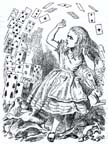
Alice not only violates the rule of polite silence and deference but does so "loudly." Her loudness escalates to brash rebellion when she expressly refuses to follow the Queen's command. She then completely shatters the only law that remains constant in Wonderland — that of the Queen yelling "Off with her or his head" — though, of course, no one bothers to follow it. When Alice names these characters with their aboveground name, "a pack of cards," she inverts the fantastical into the real and thus shatters Wonderland's hold over her as a member of its chaos. John Tenniel's illustration for the last paragraph quoted above effectively portrays Alice's abandonment of Wonderland. In addition to the pack of cars "flying down upon her," Tenniel adds a depiction of the group of animals flying away from her. These animals add greatly to the sense that Wonderland is receding from Alice, since Tenniel draws them as they are in nature. They all are appropriately differentiated in size relative to each other and to Alice. The White Rabbit and Frog-Footman have lost their clothes and are now merely a white rabbit and a frog. Tenniel also shows the animals demonstrating natural behavior: they now run away from Alice as a potentially dangerous human. The creatures of Wonderland literally flee from Alice, which is appropriate since she is the impetus behind their disintegration. Unlike the endings of some fantasies, Alice does not emerge from Wonderland in the illustration, rather Wonderland withdraws from her. In reasserting aboveground ways of thinking, she shatters the chaos that constitutes the fantasy world. Alice therefore rejects "mad sanity in favor of the sane madness of ordinary existence" (Rackin 414).
Alice in Wonderland begins by violating the boundary between animal and man but ends by reasserting the validity of that boundary. In between these two violations lies a myriad of fantastical inversions and border-crossings that continually defy Alice's aboveground way of thinking. In following her adventure through such quandaries, the reader too comes to reevaluate commonly held conceptions of language, time and space. The fantasy of Alice in Wonderland upholds J. R. R. Tolkien's principle of "recovery," as described by Brian Stableford:
The ability to take up a fantastic viewpoint can therefore aid us in putting things in a better perspective; what we "recover" in fantasy is actually a clearer sight than we normally employ in viewing the world, because it is a less narrow sight — a sight which does not take for granted the limitations of mundanity. [64]
Tolkien's insight points out potential benefit in journeys through the fantastical: the ability to reform staid approaches to looking at the world. Fantasy is therefore not, as many of its critics claim, merely escapist entertainment. Because it necessarily reflects the real world from which it departs, the genre offers valid commentary about the nature of that real world. Eric Rabkin upholds the usefulness of fantasy to the reader:
There is nothing, however, wrong with escape. If one is imprisoned, the desire to escape is sane and valuable. If the real world oppresses a reader . . . a fantastic world that handles his fears for him or, at least for the time of reading, clarifies his confusion, is a world that offers not escape but liberation. [23]
This temporary liberation from the mundane of the real world revivifies how the reader thinks and often shows him that reality itself contains more fantastical elements than one would expect.
Works Cited
"A cat may look at a king." The Oxford Dictionary of Proverbs.
Oxford University Press, 2004. Answers.com
Auden, W. H. "Today's 'Wonder-World' Needs Alice." Aspects of Alice. Edited by Robert Phillips. New York: The Vanguard Press, 1971:3-12.
Carroll, Lewis. Alice in Wonderland. New York: W. W. Norton & Company, 1992.
Johnson, Diana. "Introduction." Fantastic Illustration and Design in Britain, 1850-1930. Providence, RI: Rhode Island School of Design, 1979: 9-27.
Landow, George P. "And the World Became Strange: Realms of Literary Fantasy."Fantastic Illustration and Design in Britain, 1850-1930. Rhode Island School of Design, Providence, RI, 1979: 28-43.
Levin, Harry. "Wonderland Revisited." Aspects of Alice. Edited by Robert Phillips. New York: The Vanguard Press, 1971: 175 -197.
Rabkin, Eric. Fantastic Worlds: Myths, Tales and Stories.
Cary, NC: Oxford University Press, 1979.
Rackin, Donald. "Alice's Journey to the End of Night." Aspects of Alice. Edited by Robert Phillips. New York: The Vanguard Press, 1971: 391-416.
Reichertz, Ronald. The Making of the Alice Books. Buffalo, NY: McGill-Queen's University Press, 1997.
Stableford, Brian. "The Nineteenth Century, 1812-1899." Fantasy Literature: A Reader's Guide. Edited by Neil Barron. New York: Garland Publishing, Inc., 1990: 62-115.
Last modified December 1995